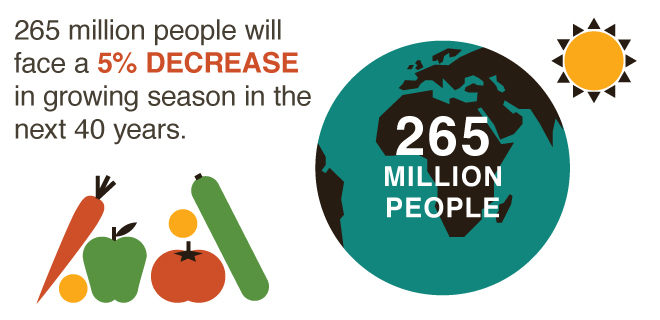Food Security

Facts
- Climate change will affect all four dimensions of food security: food availability, stability of food supplies, access to food and food utilization (Schmidhuber and Tubiello 2007). First and foremost, climate change affects food availability via its impact on yield (Tirado and Meerman 2010 p. 49).
- Climate change may affect food systems in several ways, ranging from direct effects on crop production (such as changes in rainfall that cause drought or flooding, or warmer or cooler temperatures that results in changes in the length of the growing season) to changes in markets, food prices and impacts on supply chains (Gregory et al. 2005).
- However, it is likely that socio-economic and technological trends, including changes in institutions and policies, will remain a relatively stronger driver of food security over the next few decades than climate change (Goklany 2007; Parry et al. 2009).
- Higher food prices generally make poverty worse. Although there are variations by commodity and by country, poor people generally consume more food than they produce and so tend to be hurt by higher food prices (Ivanic and Martin 2008 pp. 405, 414).
- Estimates from the current literature indicate that the impact of climate change on temperature and precipitation would lead to increased food prices by 2050. However, the complexity of such impacts is reflected in the range of estimates which vary from increases of 3-84% (not considering the impact of increased CO2 concentrations). When factoring in the effects of CO2 changes (but ignoring ozone and pest and disease impacts) these estimates indicate that global price changes could go either way, with a range of projected impacts from -30% to +45% by 2050 (Porter et al. 2014).
- Climate shocks such as droughts and floods change how people gain access to food, changing the balance between work, trade and transfers, such as from relatives who live in other climates (Devereux 2007).
- If the amount or quality of foods available decline, malnutrition tends to increase, as does incidence of infectious disease. For example, flooding, especially flash flooding caused by a single severe weather event, is likely to result in an increase in the number of people exposed to diarrhoeal and other infectious diseases, reducing their nutrient absorption capacity and reducing their immunity to infection (Tirado and Meerman 2010 p. 45).
- The way climate change affects the various aspects of food security (food availability, access, utilization and stability) are complex. For example, Tirado et al. (2010) note the following pathways:
- increase in the frequency and intensity of extreme climatic events such as heatwaves, droughts, storms, cyclones, hurricanes and floods;
- decrease in the availability of freshwater resources, and the impacts of temperature increase and water scarcity on plant or animal physiology;
- rise in sea-level and flooding of coastal lands, leading to salinization and/or contamination of water, agricultural lands and food;
- water and food hygiene and sanitation problems;
- increase in crop production as a result of CO2 fertilization;
- changes in plant and livestock diseases and pest species; and
- damage to forestry, livestock, fisheries and aquaculture.
Sources and further reading
- Devereux S. 2007. The impact of droughts and floods on food security and policy options to alleviate negative effects. Agricultural Economics 37:47–58. (Available from http://dx.doi.org/10.1111/j.1574-0862.2007.00234.x)
- Goklany IM. 2007. Integrated strategies to reduce vulnerability and advance adaptation, mitigation and sustainable development. Mitigation and Adaptation Strategies for Global Change. 12, 755-786.
- Gregory PJ, Ingram JSI, Brklacich, M. 2005. Climate change and food security. Philosophical Transactions of the Royal Society of London Series B-Biological Sciences 360(1463):2139–2148. (Available from http://dx.doi.org/10.1098/rstb.2005.1745)
- Ivanic M, Martin W. 2008. Implications of higher global food prices for poverty in low-income countries. Agricultural Economics 39: 405–416. (Available from http://dx.doi.org/10.1111/j.1574-0862.2008.00347.x)
- Parry M, Evans A, Rosegrant MW, Wheeler T. 2009. Climate Change and Hunger: Responding to the challenge. World Food Programme, Rome, Italy, pp. 1-10
- Porter JR, Xie L, Challinor A, Cochrane K, Howden M, Iqbal MM, Lobell D, Travasso MI. 2014. Food Security and Food Production Systems. In: Field CB, Barros VR, Dokken DJ, Mach KJ, Mastrandrea MD, Bilir TE, Chatterjee M, Ebi KL, Estrada YO, Genova RC, Girma B, Kissel ES, Levy AN, MacCracken S, Mastrandrea PR, White LL, eds. Climate Change 2014: Impacts, Adaptation, and Vulnerability. Part A: Global and Sectoral Aspects. Contribution of Working Group II to the Fifth Assessment Report of the Intergovernmental Panel on Climate Change. Cambridge and New York: Cambridge University Press. (Available from http://ipcc-wg2.gov/AR5/images/uploads/WGIIAR5-Chap7_FGDall.pdf)
- Schmidhuber J, Tubiello FN. 2007. Global food security under climate change. PNAS 104(50):19703–19708 (Available from doi:10.1073/pnas.0701976104).
- Tirado MC, Meerman J. 2010. Climate change and food and nutrition security. In: Thompson B, Cohen MJ, eds. The impact of climate change and bioenergy on nutrition. Rome: Food and Agriculture Organization of the United Nations and Dordrecht, The Netherlands: Springer Science+Business Media BV. (Available from doi:10.1007/978-94-007-0110-6_4).
- Tirado MC, Cohen MJ, Aberman N, Meerman J, Thompson B. 2010. Addressing the challenges of climate change and biofuel production for food and nutrition security. Food Research International 43:1729–1744. (Available from http://dx.doi.org/10.1016/j.foodres.2010.03.010)